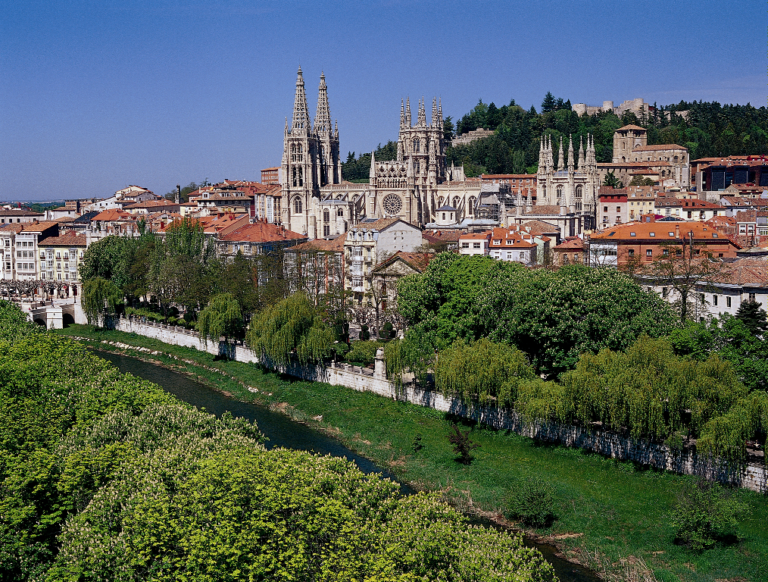This green and relaxing promenade starts at Malatos Bridge which dates back to the 13th century and was subsequently rebuilt in the 17th century. It is the crossing point for pilgrims on their way to “el Hospital del Rey”.
Paseo de la Isla starts on this bridge. It is a beautiful place full of memories and a wonderful botanical garden where you can find: chestnut trees, maples, plane trees, beeches, poplars, sequoias, cedars, cypresses, hollies …
This variety of species is displayed in generous harmony with various works of art that seem to rise from within them. On this promenade we find the gates of Conde de Castilfalé and a bit further on we reach the fountain of San Pedro de Arlanza and the vase designed by Fortunato Julian. Paseo de la Isla, where the bourgeoisie of Burgos originally stayed, became the favourite place of many locals in the last third of the 19th century.
Crossing the bridge on our way back we come across another promenade parallel to the Arlanzón river. Neither as aristocratic or as romantic as Paseo de la Isla, Paseo del Empecinado remembers the figure of the hero of the Spanish War of Independence, Juan Martín Díez. On this promenade we can also find a monument to the Americas by Andreu Alfaro.
Paseo del Espolón, is, without doubt, the most emblematic urban route, situated between the bridge of San Pablo and the bridge of Santa María. Paseo del Espolón dates back to the 18th century and is marked by the statues donated by Charles III from the Royal Palace and which represent protagonists from Medieval Burgos. This promenade meant the opening up of the city beyond the wall and became the centre of the social life of the nineteenth century bourgeoisie. Along with elegant buildings, cafes and societies like the Círculo de la Unión, the Salon de Recreos and Café Suizo emerged.
Paseo del Espoloncillo is situated on the other side of river Arlanzón, where a monolith commemorates the episode about El Cid on his way to exile. Further on we come to Paseo de Atapuerca which runs parallel to where the Museum of Human Evolution is located. Paseo de la Quinta owes its name to an old property known as ‘la Quinta del Arzobispo’, which was turned into a public park in 1868. Nowadays, this central lung constitutes a signposted botanical route. The side closest to the city centre contains a Mediterranean forest, including junipers which represent the Arlanza valley.
The journey brings us to the groves of stone pines, a cork tree and other trees that we can find in many areas of Burgos, such as black pine, holm oak, Valencian and Pyrenean oaks, species that mark the transition towards the Atlantic area of the park. In this area we discover mountain pines, a deciduous oak and the oak tree, both belonging to the Sierra de la Demanda and the provincial north. This part of the route ends with the forests of mixed deciduous trees, with lime trees, maples and ashes, sometimes accompanied by perennial species such as holly, yew trees and strawberry trees. Finally the strip of vegetation closes to the river reproduces a riverside woodland.
Following on the left bank of the river Arlanzón we arrive at Parque de Fuentes Blancas. Fuentes Blancas is one of the largest parks in Burgos and there sports and leisure facilities for little ones, a campsite and a nature classroom.



